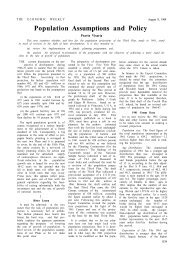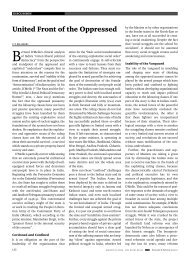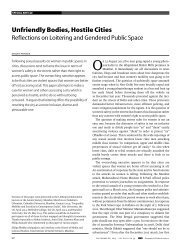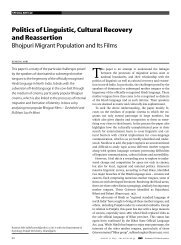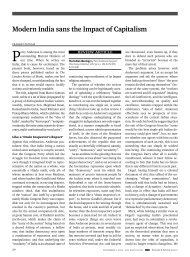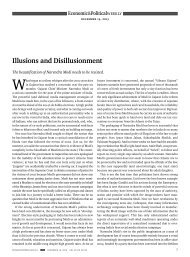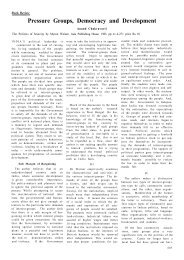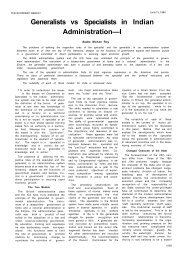Review of Twelfth Plan Proposals for Urban Transport
Review of Twelfth Plan Proposals for Urban Transport
Review of Twelfth Plan Proposals for Urban Transport
You also want an ePaper? Increase the reach of your titles
YUMPU automatically turns print PDFs into web optimized ePapers that Google loves.
REVIEW OF URBAN AFFAIRS<br />
<strong>Review</strong> <strong>of</strong> <strong>Twelfth</strong> <strong>Plan</strong> <strong>Proposals</strong><br />
<strong>for</strong> <strong>Urban</strong> <strong>Transport</strong><br />
Ranjit Gadgil<br />
The <strong>Twelfth</strong> Five-Year <strong>Plan</strong> aims to foster more inclusive<br />
and sustainable growth. <strong>Urban</strong> transport finds mention<br />
in its chapters on sustainable development,<br />
environment, and urban development, which focus not<br />
only on aspects <strong>of</strong> public transport, but also urban<br />
planning and governance. Identifying the three main<br />
themes that emerge from the <strong>Plan</strong>’s recommendations,<br />
this paper takes a critical look at them. It comments on<br />
what appears to be a significant divergence from the<br />
policy recommendations in the <strong>Plan</strong> and the <strong>Plan</strong><br />
outlays, both in the first phase <strong>of</strong> the Jawaharlal Nehru<br />
National <strong>Urban</strong> Renewal Mission and what is proposed<br />
in the second phase, be<strong>for</strong>e going on to make specific<br />
recommendations on how matters could be improved.<br />
Since the launch <strong>of</strong> the Jawaharlal Nehru National <strong>Urban</strong><br />
Renewal Mission (JNNURM) in December 2005, there<br />
has been a greater focus on the issue <strong>of</strong> urban development<br />
by the Government <strong>of</strong> India, driven by significant funding<br />
and various policy documents, in particular the National<br />
<strong>Urban</strong> <strong>Transport</strong> Policy (NUTP) that was adopted in 2006.<br />
More than seven years after the JNNURM was launched, we are<br />
now in a position to assess the impact <strong>of</strong> the mission. The debate<br />
on urban transport has been widened with the introduction<br />
<strong>of</strong> many new schemes, especially bus rapid transit (BRT)<br />
systems and metro rail projects. An annual urban mobility<br />
conference, the identification <strong>of</strong> various best practices, the<br />
publication <strong>of</strong> service-level benchmarks (SLBs) <strong>for</strong> urban transport,<br />
model agreements, tool kits, capacity-building workshops,<br />
advisories, and much more have come thick and fast<br />
from the Ministry <strong>of</strong> <strong>Urban</strong> Development in the wake <strong>of</strong> the<br />
mission. The <strong>Twelfth</strong> Five-Year <strong>Plan</strong> (2012-17) came at the end<br />
<strong>of</strong> the first phase <strong>of</strong> the JNNURM and the imminent launch <strong>of</strong><br />
its second phase, JNNURM-II. With provisional results from the<br />
Census 2011 also being available, we are better placed to assess<br />
trends in urbanisation. The <strong>Twelfth</strong> <strong>Plan</strong> is thus an important<br />
policy document that reveals how the central government<br />
intends to shape the future <strong>of</strong> urbanisation and with it, urban<br />
development, planning, and transport. Hence, this is a good<br />
time to reflect on the JNNURM-I as well as critically analyse the<br />
<strong>Twelfth</strong> <strong>Plan</strong> and the provisions in the JNNURM-II.<br />
Ranjit Gadgil (ranjit.gadgil.1@gmail.com) is the director <strong>of</strong> Janwani,<br />
a non-governmental organisation in Pune dedicated to advocating<br />
sustainable development policies and improved governance.<br />
<strong>Twelfth</strong> Five-Year <strong>Plan</strong> (2012-17)<br />
The <strong>Twelfth</strong> <strong>Plan</strong> has the tagline “faster, more inclusive and<br />
sustainable growth”, expanding on the more succinct “inclusive<br />
growth” vision <strong>of</strong> the Eleventh Five-Year <strong>Plan</strong>. Environmental<br />
sustainability was only a sub-element in the Eleventh <strong>Plan</strong>,<br />
while sustainability (not just environmental) has been made<br />
an essential feature <strong>of</strong> the current plan. The <strong>Plan</strong> seeks to<br />
promote faster gross domestic product (GDP) growth, while reducing<br />
the intensity <strong>of</strong> emissions – primarily to reduce energy<br />
needs – and being concerned about environmental consequences.<br />
Inclusivity is broadly defined; it is intended that<br />
growth benefit all sections <strong>of</strong> society, primarily the poor; be<br />
regionally balanced; promote equality; and done in a manner<br />
that is fair, accountable, transparent, participative, and socially<br />
just. The <strong>Plan</strong> goes so far as to say,<br />
The conventional ways <strong>of</strong> measuring GDP in terms <strong>of</strong> production do<br />
not take account <strong>of</strong> environmental damage caused by production <strong>of</strong><br />
certain goods which should properly be reflected as a subtraction from<br />
Economic & Political Weekly EPW november 30, 2013 vol xlviiI no 48 49
REVIEW OF URBAN AFFAIRS<br />
50<br />
GDP. Only if GDP is adjusted in this way <strong>for</strong> environmental costs that<br />
growth <strong>of</strong> adjusted GDP can be called a measure <strong>of</strong> the increase in total<br />
production in the economy.<br />
To this end, the central government released a framework<br />
<strong>for</strong> Green National Accounts in March 2013 (MoSPI 2013).<br />
The <strong>Twelfth</strong> <strong>Plan</strong> sets “a vision <strong>of</strong> India moving <strong>for</strong>ward in a<br />
way that would ensure a broad-based improvement in living<br />
standards <strong>of</strong> all sections <strong>of</strong> the people through a growth<br />
process which is faster than in the past, more inclusive and<br />
also more environmentally sustainable”. This is a significant<br />
position articulated by the <strong>Plan</strong>ning Commission, which in<br />
many ways is close to the definition <strong>of</strong> sustainable development<br />
held by proponents <strong>of</strong> holistic, as opposed to purely GDPdriven,<br />
growth models. <strong>Urban</strong> transport is dealt with largely<br />
in three sections <strong>of</strong> the <strong>Plan</strong> – “Sustainable Development”<br />
(Chapter 4), “Environment” (Chapter 7), and “<strong>Urban</strong> Development”<br />
(Chapter 18). While there is considerable overlap, justifiably<br />
so, each deals with different aspects <strong>of</strong> urban transport,<br />
and we can identify three broad themes.<br />
Theme 1: Energy Efficiency<br />
The <strong>Twelfth</strong> <strong>Plan</strong> is particularly concerned with energy efficiency,<br />
stating that faster growth will need ever more energy,<br />
which is a limited resource that has an ecological cost. This is<br />
consistent with India’s pledge to reduce the energy intensity <strong>of</strong><br />
its economy by 20-25% by 2020 (MoEF 2010). It there<strong>for</strong>e<br />
stresses the need to be able to manage the demand <strong>for</strong> more<br />
energy without sacrificing growth by finding and promoting<br />
energy-efficiency across all sectors, especially those that rely<br />
almost exclusively on fossil fuels. It recommends,<br />
• Developing technologies <strong>for</strong> more energy-efficient vehicles.<br />
• Reducing subsidies to fuel, especially diesel, which it calls<br />
“large and regressive”. In addition to having fiscal implications,<br />
it “has distorted the use <strong>of</strong> energy in transport” and<br />
“worsened the problem <strong>of</strong> hazardous air pollution”.<br />
• Promoting public and non-motorised transport in cities and<br />
rail <strong>for</strong> intercity passenger travel, while discouraging the use<br />
<strong>of</strong> private vehicles in urban areas.<br />
Energy efficiency is such a dominant theme <strong>of</strong> the <strong>Twelfth</strong><br />
<strong>Plan</strong> that even while categorically stating that the eight missions<br />
under the National Action <strong>Plan</strong> on Climate Change<br />
(NAPCC) must be an integral part <strong>of</strong> it, reducing carbon emissions<br />
is seen only as a co-benefit. The main reasons to reduce<br />
the energy intensity <strong>of</strong> growth are to save energy, increase<br />
energy security, and reduce emissions. Even the higher cost<br />
<strong>of</strong> renewable energy sources is rationalised on the basis <strong>of</strong><br />
the “cost <strong>of</strong> environmental damage”, which it claims is not<br />
properly measured and taken into account. This line <strong>of</strong><br />
thought becomes a powerful reason <strong>for</strong> supporting nonmotorised<br />
transport, the stark contrast being pointed out in<br />
paragraph 4.98.<br />
(1) Only 4% <strong>of</strong> the total passenger transport activity is by private automobiles<br />
in cities, but they contribute about 20% <strong>of</strong> passenger transport<br />
emissions.<br />
(2) Non-motorised transport supports 4% <strong>of</strong> passenger transport<br />
a ctivity in the country without causing any emissions at all.<br />
Quite consistent with its overarching theme, one <strong>of</strong> the lowcarbon<br />
strategies, “better urban public and non-motorised<br />
transport”, is evaluated on the basis <strong>of</strong> growth, inclusion, the<br />
environment, and carbon mitigation thus,<br />
Growth – Mildly positive – reduced fuel imports and savings on fuel<br />
expenditure could get invested domestically.<br />
Inclusion – Positive – mobility <strong>for</strong> the poor would improve significantly.<br />
Local Environment – Positive – reduced local emissions.<br />
Carbon Mitigation – Positive – reduced consumption <strong>of</strong> fossil fuels.<br />
While this is not an unreasonable assessment, the emphasis<br />
on energy savings leads to undervaluing the full benefits that<br />
would accrue from having better public and non-motorised<br />
transport. Specifically, the <strong>Plan</strong> fails to mention that the<br />
growth benefits <strong>of</strong> this strategy would be enhanced by<br />
• reduced congestion in cities, which are becoming more<br />
s everely gridlocked with each passing day, thus reducing loss<br />
<strong>of</strong> productivity; 1<br />
• substantial financial savings <strong>for</strong> cities if they spend more on<br />
public transport and less on road infrastructure, flyovers, and<br />
parking lots; 2<br />
• lowered losses due to improved health <strong>of</strong> citizens and less<br />
loss <strong>of</strong> life; 3 and<br />
• economic benefits from an increase in business related to<br />
public transport, cycling, and related technologies. 4<br />
The inclusivity benefits would also be greater since it is not<br />
only the poor, but also women, the disabled, senior citizens,<br />
and children who would benefit from better public modes <strong>of</strong><br />
transport. The massive infrastructure needed <strong>for</strong> urban road<br />
projects meant primarily <strong>for</strong> private vehicles has deleterious<br />
effects on the urban poor whose livelihoods and settlements<br />
are displaced. These projects also severely affect natural habitats,<br />
green cover, and open spaces, and are thus more harmful<br />
to the local environment. Their carbon footprint is also substantial.<br />
A reduced need <strong>for</strong> such infrastructure projects will<br />
have positive effects across aspects beyond those considered.<br />
Interestingly, the <strong>Twelfth</strong> <strong>Plan</strong> recommends a reorganisation<br />
<strong>of</strong> the NAPCC. It suggests that the sustainable habitats mission<br />
should address issues related to urban planning and development,<br />
while “improving public transport” is to be a “policy<br />
thrust area” to be taken up under the JNNURM-II, which would<br />
be able to make the required funds available. While this makes<br />
sense, it does not substantially change the current situation<br />
since the JNNURM was already focusing on the improvement <strong>of</strong><br />
public and non-motorised transport in cities. This <strong>for</strong>mulation<br />
does, however, squarely put the onus <strong>of</strong> accomplishing the<br />
goals set in the <strong>Twelfth</strong> <strong>Plan</strong> on this on the JNNURM.<br />
Theme 2: Governance, <strong>Urban</strong> Management and <strong>Plan</strong>ning<br />
The McKinsey (2010) report on urbanisation in India brought<br />
in the new thinking on this subject, and it was picked up<br />
and taken <strong>for</strong>ward by the report <strong>of</strong> the High-Powered<br />
Expert Committee (2011) <strong>for</strong> estimating the investment requirements<br />
<strong>for</strong> urban infrastructure services. The <strong>Twelfth</strong> <strong>Plan</strong><br />
later cast it in the <strong>for</strong>m <strong>of</strong> a national policy. In this new paradigm,<br />
urbanisation is seen as being inevitable (with various<br />
trends and projections cited to support this) and desirable,<br />
november 30, 2013 vol xlviiI no 48 EPW Economic & Political Weekly
since it p romotes productivity (through claims <strong>of</strong> “economies <strong>of</strong><br />
scale”) and inclusivity, with cities being portrayed as melting<br />
pots where caste, religion, and gender divisions break down.<br />
The fact that cities are, however, in crisis is acknowledged,<br />
both with regard to the lack <strong>of</strong> basic civic services and ecological<br />
degradation, which leads to a two-pronged solution – fix<br />
urban governance and invest more in much-needed urban infrastructure.<br />
There are several contradictions in these prescriptions,<br />
both in principle and in practice, and perhaps a bias,<br />
as we shall attempt to show in the context <strong>of</strong> urban transport.<br />
Fixing <strong>Urban</strong> Governance<br />
The <strong>Twelfth</strong> <strong>Plan</strong> and the reports that preceded it are correct<br />
in linking the poor quality <strong>of</strong> public transport (as well as other<br />
services) to weak urban governance and inadequate personnel<br />
and institutional capacities. The main issues identified are a<br />
lack <strong>of</strong> planning, especially integrating land use and transport<br />
at the planning stage, the absence <strong>of</strong> integrated <strong>Plan</strong>s at the<br />
metropolitan region level, and poor coordination between the<br />
various authorities. In keeping with the overall theme <strong>of</strong> the<br />
<strong>Plan</strong>, a vision is put <strong>for</strong>th, which states that cities must be peoplecentric,<br />
foster greater people participation, and <strong>of</strong>fer highquality<br />
civic services (<strong>for</strong> example, “safe and af<strong>for</strong>dable public<br />
transport services”) to all sections <strong>of</strong> society, while protecting<br />
the environment through the efficient use <strong>of</strong> energy, water,<br />
and land. To achieve this, the <strong>Plan</strong> points out,<br />
• Need thrust towards improvement in governance structure<br />
and a major improvement in delivery <strong>of</strong> services (including<br />
public transport) in cities.<br />
• Need to step up investments and also fix weaknesses in<br />
u rban governance and management.<br />
• Capacity building should be a separate submission <strong>of</strong><br />
JNNURM with 10% funds allocated <strong>for</strong> this.<br />
The major governance overhaul that is proposed is more<br />
empowered city mayors, who are to be recast as city managers<br />
or city chief executive <strong>of</strong>ficers (CEOs) with greater executive<br />
powers, thus avoiding the political quagmire that tends to slow<br />
down bold decision-making, deemed necessary <strong>for</strong> the fasttrack<br />
trans<strong>for</strong>mation <strong>of</strong> cities into “engines <strong>of</strong> growth”. At the<br />
metropolitan region level, constituting and strengthening<br />
district and metropolitan planning committees (DPCs/MPCs),<br />
as mandated in the 74th Constitutional Amendment Act, which<br />
will be responsible <strong>for</strong> a spatial development plan <strong>for</strong> the<br />
region, including a regional transport plan, are emphasised.<br />
The <strong>Plan</strong> reiterates the need <strong>for</strong> both a metropolitan development<br />
authority and a unified metropolitan transport authority<br />
(UMTA), presumably to operate under the aegis <strong>of</strong> the MPC<br />
(although this is not explicitly stated in the case <strong>of</strong> the UMTA),<br />
which will act as technical and regulatory bodies at the<br />
regional level. It expects each city/town to prepare a development<br />
plan that will, inter alia, provide <strong>for</strong><br />
• Strategic densification especially along mass transit corridors<br />
with mixed land use.<br />
• City mobility plan with special emphasis <strong>of</strong> making cities<br />
safe <strong>for</strong> vulnerable groups including women and children,<br />
p edestrian and cyclists.<br />
REVIEW OF URBAN AFFAIRS<br />
The specific recommendation <strong>for</strong> so-called “strategic densification”<br />
is part <strong>of</strong> a larger urban agenda, laid bare in the<br />
opening sections <strong>of</strong> the <strong>Twelfth</strong> <strong>Plan</strong>.<br />
Since overall government resources are limited and must be applied to<br />
other priority sectors such as health and education, it is necessary that<br />
cities, especially the larger ones, and progressively even the smaller<br />
ones, are encouraged and enabled to draw resources from the market<br />
and the private sector.<br />
For this, they must improve their governance and ability to implement<br />
projects. They will also have to manage their land resources more strategically,<br />
both to ensure better land use and to secure what will be a<br />
principal resource <strong>for</strong> their future financial needs. They must become<br />
able to recover adequate service charges, and equitably, from their inhabitants<br />
(paragraph 1.166).<br />
How infrastructure in cities is to be financed thus becomes<br />
clear – land is to be leveraged and it is necessary <strong>for</strong> cities to be<br />
able to exploit this vast untapped resource. <strong>Transport</strong>-oriented<br />
development (TOD) is then a tool to unleash the economic<br />
potential <strong>of</strong> this land, paving the way <strong>for</strong> large infrastructure<br />
projects, which will supposedly make the cities “world class”.<br />
Two comments are essential here. The first is to recognise that<br />
while urban land is a potentially significant resource that<br />
should be used effectively by cities, the combination <strong>of</strong> rampant<br />
corruption in land deals, extremely weak urban governance<br />
systems, and poor planning capacity is more likely to rob<br />
urban India <strong>of</strong> its most precious asset rather than help mobilise<br />
finances <strong>for</strong> infrastructure. Given woefully inadequate public<br />
amenities, open and public spaces, and a critical shortage <strong>of</strong><br />
public housing, the blanket exercise <strong>of</strong> strategic densification<br />
is a potential recipe <strong>for</strong> disaster.<br />
The <strong>Plan</strong> itself admits that cities are already dense and any<br />
increase in the floor area ratio (FAR)/floor space index (FSI)<br />
ought to increase per capita space availability – essentially bigger<br />
tenement sizes. Hence the description “strategic densification”<br />
is misplaced, and borrowed from Western urban typologies,<br />
where it has been argued that densification <strong>of</strong> sparse suburbs<br />
is essential <strong>for</strong> supporting mass transit systems. Indian<br />
cities are already dense, short <strong>of</strong> space, and growing. Public<br />
transport systems are unable to meet even the existing demand,<br />
and there is no need <strong>for</strong> further densification to generate<br />
demand. What is needed is better quality and greater supply<br />
<strong>of</strong> public transport. Sale <strong>of</strong> land near metro and other transit<br />
corridors is thus purely <strong>for</strong> raising capital to fund projects<br />
rather than generate demand. Densification strategies have<br />
been critiqued in the west (Neuman 2005; Breheny 1995), yet<br />
the repercussions <strong>of</strong> a wholesale increase in FAR is poorly<br />
understood or studied in the Indian context and bar Delhi,<br />
which has taken up more detailed TOD strategies (UTTIPEC<br />
2010), are more likely to be implemented poorly. 5<br />
More significantly, the approach to better city planning by the<br />
governments at both the state and central levels remains<br />
warped. The JNNURM has made the preparation <strong>of</strong> city development<br />
plans (CDPs) mandatory <strong>for</strong> access to funding. CDPs are<br />
prepared by consultants empanelled by the Ministry <strong>of</strong> <strong>Urban</strong><br />
Development. The planning amounts to little more than preparation<br />
<strong>of</strong> a city investment plan, done in a hurried manner, with<br />
no statutory public consultation process. The plans are not<br />
Economic & Political Weekly EPW november 30, 2013 vol xlviiI no 48 51
REVIEW OF URBAN AFFAIRS<br />
v etted by the ministry, and compliance with even its own policies,<br />
such as the NUTP, is not en<strong>for</strong>ced. These JNNURM CDPs are<br />
also at odds with the statutory “master plans”, “land use plans”,<br />
or “development plans” to be prepared by urban local bodies<br />
under state planning acts. By introducing this ad hoc process,<br />
the JNNURM has vitiated the states’ planning processes, rather<br />
than strengthened them. State governments, in turn, have refused<br />
to let go <strong>of</strong> the powers they possess over the planning<br />
process – all urban development plans in a state as well as any<br />
subsequent changes to them are subject to approval and changes<br />
dictated by the state government. Neither the state nor central<br />
governments have taken the only logical step, which would be<br />
making cities wholly capable <strong>of</strong> and responsible <strong>for</strong> better planning<br />
by creating strong urban planning departments at the city<br />
level, guided by policies that would ensure transparency, and<br />
insist on meeting clear social and environmental targets.<br />
As a way to “step up investments”, public-private partnerships<br />
(PPPs) are favoured. These are seen as more efficient, able<br />
to raise capital, and improve the quality <strong>of</strong> projects. This rosy<br />
view <strong>of</strong> PPPs needs to be tempered by the failures <strong>of</strong> the London<br />
Underground PPP (NAO 2009) ef<strong>for</strong>t and the more recent<br />
Delhi Airport Express Line Metro. 6 The causes <strong>for</strong> the failure <strong>of</strong><br />
these PPP arrangements were varied but the reasons included<br />
the complexity <strong>of</strong> the agreements, the long time-frames and<br />
the uncertainties that arose from it, and the lack <strong>of</strong> transparent<br />
and robust mechanisms <strong>for</strong> renegotiation. The <strong>Twelfth</strong> <strong>Plan</strong><br />
does require “participation <strong>of</strong> people, specification <strong>of</strong> service<br />
standards, outcomes and monitoring as necessary prerequisites”,<br />
but these alone will not be sufficient to ensure successful<br />
PPPs. The inclusion <strong>of</strong> PPP projects under the Right to In<strong>for</strong>mation<br />
Act (DoPT 2013) after initial reluctance by the <strong>Plan</strong>ning<br />
Commission is a small but essential step, but clearly much<br />
more needs to be done to make PPPs work. 7<br />
• For metro rail projects, the <strong>Plan</strong> <strong>of</strong>fers a curious mix.<br />
• For metro in high density corridors and which are “viable on<br />
their own”, with admissible VGF [viability gap funding] and<br />
real estate development on land ordinarily required <strong>for</strong> the<br />
project should be done by PPP.<br />
• For metro requiring additional real estate development<br />
rights should be taken up by the government.<br />
• O and M [operation and maintenance] <strong>of</strong> metro and BRT<br />
projects should be done by PPP, especially components such as<br />
depots, stations and terminals.<br />
The <strong>Plan</strong> implicitly seems to acknowledge that metro projects<br />
funded primarily through real estate development can be prone to<br />
extreme uncertainty and also manipulation (Ramachandraiah<br />
2009), with undue financial advantage accruing to the metro<br />
builder while most <strong>of</strong> the risk is underwritten by the state. Fare setting<br />
is already emerging as an issue in the absence <strong>of</strong> any regulatory<br />
mechanism <strong>for</strong> metros. 8 The <strong>Plan</strong> touts the Delhi Metro as a success,<br />
responsible <strong>for</strong> “trans<strong>for</strong>ming the public transport system in<br />
NCR region”, but <strong>of</strong>fers no measure <strong>for</strong> determining this. The debate<br />
about the success <strong>of</strong> metro rail projects is still being played out,<br />
with strong endorsements by proponents (Ramachandran 2012)<br />
being countered by those who remain sceptical about whether it is<br />
a cost-effective solution <strong>for</strong> Indian cities (Ramachandraiah 2012).<br />
52<br />
Given the clamour <strong>for</strong> metro rail projects in other cities,<br />
<strong>of</strong>ten driven by considerations other than transport itself,<br />
the <strong>Plan</strong> <strong>of</strong>fers four rules <strong>of</strong> thumb <strong>for</strong> determining if a city<br />
qualifies <strong>for</strong> a metro.<br />
• Peak hour peak direction traffic <strong>of</strong> more than 20,000 <strong>for</strong> at<br />
least 5 km <strong>of</strong> continuous length by 2021.<br />
• Total population <strong>of</strong> more than two million as per 2011 Census.<br />
• Average trip length <strong>of</strong> more than 7-8 km <strong>for</strong> motorised trips.<br />
• At least 1 million ridership per day on organised public<br />
transport.<br />
It cautions that “these criteria are in the nature <strong>of</strong> guidelines<br />
and are not to be construed as entitlement <strong>for</strong> a metro rail<br />
project” and that “as huge public money is involved in construction<br />
<strong>of</strong> these projects, a thorough cost-benefit analysis<br />
across available modes <strong>of</strong> transport is to be ensured in case <strong>of</strong><br />
every project”. However, given that neither do any <strong>for</strong>mats <strong>for</strong><br />
such cost-benefit analyses exist, nor are any processes defined<br />
<strong>for</strong> the scrutiny <strong>of</strong> these reports, and the whole decisionmaking<br />
process is largely opaque, decisions about whether,<br />
and which, metro rail projects will be “cleared” by the central<br />
government are likely to remain political ones (Sreenivas 2011).<br />
No robust frameworks <strong>for</strong> cost-benefit analyses, specifically <strong>for</strong><br />
the Indian context, have been developed. A tool kit prepared by<br />
the Ministry <strong>of</strong> <strong>Urban</strong> Development <strong>for</strong> alternative analysis<br />
(WSA 2008), finds no mention anywhere in processes defined<br />
by the ministry <strong>for</strong> the evaluation <strong>of</strong> proposals <strong>for</strong> funding.<br />
The lack <strong>of</strong> mention <strong>of</strong> processes and evaluation tools is a<br />
major omission in the <strong>Plan</strong>.<br />
Theme 3: Sustainable <strong>Transport</strong><br />
The <strong>Twelfth</strong> <strong>Plan</strong> quite explicitly cites the NUTP as the basis <strong>for</strong><br />
its own recommendations. Hence it calls <strong>for</strong> policies to encourage<br />
greater use <strong>of</strong> public and non-motorised transport in India’s<br />
cities and towns, while discouraging the use <strong>of</strong> private motor<br />
vehicles. The <strong>Plan</strong> sets a specific target <strong>of</strong> 50% <strong>of</strong> motorised<br />
trips to be catered <strong>for</strong> by public transport by the end <strong>of</strong> the <strong>Plan</strong><br />
period (paragraph 18.98). While this is a positive suggestion, it<br />
is not very ambitious. As per a 2008 study by the Ministry <strong>of</strong><br />
<strong>Urban</strong> Development (MoUD 2008), 44% <strong>of</strong> urban motorised<br />
trips (27% <strong>of</strong> all trips) were already being catered <strong>for</strong> by public<br />
transport. In megacities (with more than eight million population),<br />
the share <strong>of</strong> public transport was already 63% <strong>of</strong> motorised<br />
trips. Ironically, these are the very cities <strong>for</strong> which metro<br />
rail projects are proposed and hence will get the lion’s share <strong>of</strong><br />
future public funding in transport. A careful look at the MoUD<br />
study reveals that million-plus cities (with populations greater<br />
than one million but less than 10 million) suffer from a severe<br />
lack <strong>of</strong> public transport systems, which inevitably results in an<br />
explosion in the number <strong>of</strong> private vehicles. Whether these cities<br />
will be able to plan and implement quality public transport<br />
projects remains a big question and neither the <strong>Twelfth</strong> <strong>Plan</strong><br />
nor the JNNURM provide any satisfactory answers.<br />
The <strong>Plan</strong> rightly perceives that public transport is burdened<br />
by a perverse tax regime and calls <strong>for</strong> reduced taxes. A specific<br />
and welcome suggestion is to refund fuel taxes. It recognises<br />
that urban transport is a state subject and that the central<br />
november 30, 2013 vol xlviiI no 48 EPW Economic & Political Weekly
g overnment has limited levers, the JNNURM being one <strong>of</strong> them.<br />
It, however, makes certain broad recommendations.<br />
• Promotion <strong>of</strong> urban rail systems;<br />
• City mobility plans and integrating various modes <strong>of</strong> transport<br />
through initiatives such as common mobility cards;<br />
• Taxes and congestion charging to disincentivise private<br />
v ehicles;<br />
• Social and gender auditing <strong>of</strong> urban transport projects;<br />
• <strong>Urban</strong> transport departments at the state level;<br />
• Promotion <strong>of</strong> non-motorised transport; and<br />
• State-level safety commissions.<br />
Though mandatory, mobility plans prepared by cities have<br />
been found to have deficiencies (Chotani 2010; TERI 2011) and<br />
these do not seem to have been vetted by the ministry. More<br />
disconcerting, the <strong>Plan</strong>s remain on paper with the ministry neither<br />
insisting on their implementation nor having any mechanism<br />
to track compliance. With rapidly increasing fuel prices,<br />
the government has been unwilling to raise taxes on private<br />
vehicles. Congestion charging has been recommended by the<br />
ministry in an advisory (MoUD 2013), but given the technical<br />
complexity <strong>of</strong> these schemes and a lack <strong>of</strong> political will, this too<br />
remains on paper. The recommendations <strong>for</strong> promoting nonmotorised<br />
transport are especially disappointing, stating,<br />
“While renovating arterial roads or new road projects, it should<br />
be ensured that the project provides <strong>for</strong> pedestrian path and<br />
bicycle lanes, wherever the space permits”. This reduces planning<br />
<strong>for</strong> non-motorised transport to merely an add-on to road<br />
projects and dilutes the absolute necessity <strong>of</strong> having adequate<br />
footpaths and cycle tracks. Finally, given the unacceptably high<br />
number <strong>of</strong> traffic accidents in cities, safety needs to be put in<br />
the spotlight through an insistence on better street design,<br />
starting with adherence to Indian Roads Congress (IRC) guidelines.<br />
Making safety the responsibility <strong>of</strong> the urban local authority,<br />
which implements infrastructure projects, is also likely<br />
to lead to safer streets than having a state-level commission.<br />
Inclusivity in <strong>Urban</strong> <strong>Transport</strong><br />
As mentioned, the <strong>Twelfth</strong> <strong>Plan</strong> places considerable emphasis<br />
on “inclusivity”. One <strong>of</strong> the hallmarks <strong>of</strong> sustainable, or peoplecentric<br />
(as opposed to vehicle-centric) transport planning is<br />
that it is inherently non-discriminatory. While this aspect is<br />
not explicitly mentioned in the “<strong>Urban</strong> <strong>Transport</strong>” section, one<br />
finds other aspects <strong>of</strong> “inclusivity” elsewhere in the <strong>Plan</strong>.<br />
These include the following.<br />
Women and Child Rights: The <strong>Plan</strong> recommends addressing<br />
women-specific transport needs, providing dedicated services<br />
such as ladies special buses, and toilets <strong>for</strong> women, and security<br />
through pre-project gender assessment and gender audits.<br />
Persons with Disabilities: To reduce discrimination in transport,<br />
the <strong>Plan</strong> adopts the two-pronged strategy <strong>of</strong> incorporating service<br />
delivery, and generating public awareness about disability rights.<br />
Senior Citizens: The <strong>Plan</strong> acknowledges that given the increase<br />
in the number <strong>of</strong> senior citizens, their issues must be<br />
REVIEW OF URBAN AFFAIRS<br />
addressed. It mentions that this will be done by way <strong>of</strong> the National<br />
Policy on Senior Citizens, which is yet to be finalised.<br />
But the draft policy recommends,<br />
Age friendly, barrier-free access will be created in buses and bus stations,<br />
railways and railway stations, airports and bus transportation<br />
within the airports, banks, hospitals, parks, places <strong>of</strong> worship, cinema<br />
halls, shopping malls and other public places that senior citizens and<br />
the disabled frequent (MoSJ 2011).<br />
Much more stringent adherence to existing acts and guidelines,<br />
utterly lacking now, should have been recommended.<br />
The Persons with Disabilities Act, 1995 already makes it<br />
mandatory <strong>for</strong> public transport and public spaces to be<br />
barrier-free, and guidelines <strong>of</strong> both the central public works<br />
department (CPWD) and the IRC give detailed instructions<br />
Figure 1: JNNURM Fund Allocation<br />
(<strong>Urban</strong> <strong>Transport</strong>)<br />
Other urban<br />
transport<br />
5%<br />
Mass rapid transit<br />
34%<br />
Roads/flyovers/RoB<br />
55%<br />
on how to achieve this. Yet<br />
these are disregarded at<br />
every level. The <strong>Plan</strong> should<br />
have strongly urged the<br />
JNNURM-II to make accessibility<br />
audits an integral<br />
part <strong>of</strong> project compliance<br />
<strong>for</strong> funding. Similar gender<br />
audits should have also been<br />
made mandatory. In both<br />
cases, substantial awareness<br />
and capacity building<br />
among the authorities, more<br />
than the public, is required <strong>for</strong> these issues to become a part <strong>of</strong><br />
how projects are designed and implemented.<br />
JNNURM and Financial Layouts in the <strong>Twelfth</strong> <strong>Plan</strong><br />
An assessment <strong>of</strong> urban transport funding under the JNNURM (JN-<br />
NURM 2012) reveals some significant facts. The JNNURM consists<br />
<strong>of</strong> two schemes, the <strong>Urban</strong> Infrastructure and Governance (UIG)<br />
submission <strong>for</strong> million-plus urban agglomerations (UAs) and<br />
s elect capital and other cities, and the <strong>Urban</strong> Infrastructure Development<br />
Scheme <strong>for</strong> Small and Medium Towns (UIDSSMT) <strong>for</strong> all<br />
other cities and towns. Under the UIG, Rs 15,374 crore was allocated<br />
<strong>for</strong> urban transport projects (total approved cost) and an<br />
additional Rs 4,724 crore <strong>for</strong> the purchase <strong>of</strong> buses, and Rs 1,014<br />
crore <strong>for</strong> roads under the UIDSSMT. As Figure 1 shows, despite the<br />
emphasis on public transport and non-motorised transport, more<br />
than 50% <strong>of</strong> the UIG funds (not considering the funds <strong>for</strong> buses)<br />
were allocated <strong>for</strong> roads, flyovers, and railway overbridges.<br />
As per Census 2011, the total urban population <strong>of</strong> India<br />
stands at 377 million. A summary <strong>of</strong> the distribution among<br />
various population categories is given in Table 1.<br />
Table 1: <strong>Urban</strong> Population Distribution Summary, Census 2011<br />
Census 2011 Total <strong>Urban</strong> 100,000 + 1 million +<br />
Population (million) 377 265 161<br />
Number <strong>of</strong> UAs/cities/towns* 4,041 468 53<br />
* Only statutory towns considered.<br />
Source: Census 2011.<br />
The allocation in the UIDSSMT <strong>for</strong> urban transport is less than<br />
5% that <strong>of</strong> the UIG. Since the UIG is primarily focused on millionplus<br />
cities, with some other select capital and special cities, the<br />
overall funding is very imbalanced (Table 2, p 54).<br />
Economic & Political Weekly EPW november 30, 2013 vol xlviiI no 48 53<br />
Parking<br />
lots<br />
6%
REVIEW OF URBAN AFFAIRS<br />
Figure 2 shows that the allocations even within cities shows<br />
a very wide variation, not just in total funds allocated, but also<br />
per capita. Just the top four cities got a whopping 54% <strong>of</strong> all<br />
urban transport funding under the JNNURM, while accounting<br />
<strong>for</strong> only 26% <strong>of</strong> the urban population.<br />
Table 2: JNNURM Funding Distribution across Cities<br />
Cities/Population Funded < 1,00,000 Between 1,00,000 1 million +<br />
Under JNNURM (<strong>Urban</strong> <strong>Transport</strong>)<br />
and 1 million<br />
Population (million) Less than 7 <strong>of</strong> 112 16 <strong>of</strong> 104 145 <strong>of</strong> 161<br />
(6%) (15%) (90%)<br />
Number <strong>of</strong> UAs/cities/towns* 87 <strong>of</strong> 3,959 41 <strong>of</strong> 415 41 <strong>of</strong> 53<br />
(2%) (10%) (77%)<br />
* Only statutory towns considered.<br />
Source: Based on JNNURM funding data and Census 2011 data.<br />
With funding under the UIG scheme much larger in magnitude<br />
than the UIDSSMT, states with urban populations concentrated<br />
in million-plus UAs typically got higher funding<br />
(Figure 3). However, states such as Uttar Pradesh, Tamil Nadu<br />
and Kerala did poorly even then.<br />
Figure 2: JNNURM Funding (Total and Per Capita); Top Cities<br />
Allocation (crore)<br />
Source: Based on JNNURM funding data and Census 2011 data.<br />
The main conclusions that one can draw from this analysis are<br />
(1) JNNURM funds have not been allocated according to the<br />
primary focus areas <strong>of</strong> the NUTP.<br />
(2) Allocation <strong>of</strong> funds has been very uneven with some cities<br />
and states benefiting far more than others.<br />
54<br />
6,000<br />
5,000<br />
4,000<br />
3,000<br />
2,000<br />
1,000<br />
0<br />
Delhi<br />
Buses<br />
UIG<br />
Kolkata<br />
Pune<br />
Per capita<br />
Ahmedabad<br />
Bangalore<br />
Greater Mumbai<br />
Figure 3: JNNURM Funding State-wise; Top States<br />
JNNURM allocation (crore)<br />
6,000<br />
5,000<br />
4,000<br />
3,000<br />
2,000<br />
1,000<br />
0<br />
Delhi NCT<br />
Buses<br />
UIG<br />
Maharashtra<br />
West Bengal<br />
Gujarat<br />
Karnataka<br />
Andhra Pradesh<br />
Jaipur<br />
Madhya Pradesh<br />
Source: Based on JNNURM funding data and Census 2011 data.<br />
Surat<br />
Rajasthan<br />
Visakhapatnam<br />
Hyderabad<br />
UIDSSMT<br />
Indore<br />
Pop (UAs > 1 mn<br />
Tamil Nadu<br />
Uttar Pradesh<br />
Punjab<br />
(3) Funds have been allocated to larger cities (million plus) to a<br />
far greater extent than cities between 1,00,000 and a million.<br />
In short, the funding has been more to fix big city problems<br />
that address the issue <strong>of</strong> urban transport across the country,<br />
with very little being done to prevent future problems that are<br />
likely to arise as the Tier I cities grow, and which will see the<br />
largest shift to personal vehicles.<br />
Against this background, the <strong>Twelfth</strong> <strong>Plan</strong> suggests the following<br />
budgetary layout – 75% urban roads, 20% mass transit,<br />
with most <strong>of</strong> it earmarked <strong>for</strong> metro rail, and less than 2% on<br />
capacity building. In addition, it recommends that funding<br />
u nder the JNNURM-II should follow these guidelines.<br />
• Require adherence to approved development plans as well<br />
as other re<strong>for</strong>m and financial conditions.<br />
• All urban transport projects which improve public transport<br />
are admissible.<br />
• <strong>Urban</strong> roads constitute a large fraction <strong>of</strong> investment in urban<br />
sector and since JNNURM is fungible, urban road projects<br />
should be admissible. Metro rail projects<br />
- 4,500<br />
which meet the 4 rules <strong>of</strong> thumb mentioned<br />
- 4,000 earlier, but nonetheless subject to a thorough<br />
cost-benefit analysis.<br />
- 3,500<br />
- 3,000 By allowing urban road projects to be admissible<br />
under the JNNURM-II, the very heart<br />
- 2,500<br />
<strong>of</strong> conditional funding under the scheme<br />
- 2,000<br />
has been cut out. The JNNURM-I was restrictive<br />
in its funding, having reduced funding<br />
- 1,500<br />
- 1,000<br />
<strong>for</strong> projects meant only <strong>for</strong> new roads and<br />
- 500<br />
flyovers, knowing full well that cities would<br />
- 0<br />
be much more inclined to seek support <strong>for</strong><br />
such projects at the expense <strong>of</strong> public transport<br />
and non-motorised transport.<br />
Mysore<br />
Chennai<br />
Per capita<br />
Recommendations<br />
The JNNURM has overly relied on funding<br />
projects as a way to influence urban transport.<br />
35<br />
While recognising that the planning, design,<br />
30 implementation, and monitoring systems<br />
25<br />
have to improve, there has been little progress<br />
on that front. The task at hand is considerable<br />
20<br />
and increasing in magnitude. A more practical<br />
approach must be based on decentralising<br />
15<br />
the process <strong>of</strong> improvement, starting with the<br />
10<br />
state governments, and levering their ability<br />
5 to push re<strong>for</strong>ms in cities. The creation <strong>of</strong> state<br />
urban transport policies, modelled on the<br />
0<br />
NUTP, could be an important step in that direction.<br />
Additionally, the JNNURM-II can help<br />
catalyse change by insisting on better processes<br />
and, most critically, by allocating funds<br />
<strong>for</strong> capacity building. It must also ensure regional<br />
balance and comprehensively cover the whole <strong>of</strong> urban<br />
India. Specifically, the JNNURM-II should do the following.<br />
(1) Allocate at least 10% funds to build capacity at the central,<br />
state, and city levels, in line with the recommendation in the<br />
<strong>Plan</strong> (section: 18.72).<br />
Kerala<br />
Bihar<br />
Population (millions)<br />
november 30, 2013 vol xlviiI no 48 EPW Economic & Political Weekly
REVIEW OF URBAN AFFAIRS<br />
(2) Insist on full compliance with the 74th Constitutional<br />
Amendment Act, including the setting up <strong>of</strong> the DPCs/MPCs<br />
and other institutional frameworks at the regional level.<br />
(3) Remove the JNNURM’s CDP process and encourage city<br />
master plans as per state town planning acts, building capacity<br />
at all levels <strong>for</strong> better-quality planning techniques.<br />
(4) Encourage cities to adopt street design guidelines that promote<br />
the equitable allocation <strong>of</strong> road space and enhance the<br />
safety <strong>of</strong> road users, in particular pedestrians and cyclists, and<br />
comply with all the IRC and disability guidelines.<br />
(5) Make mandatory comprehensive mobility plans and fund<br />
against outcomes, not just physical projects.<br />
(6) Funding <strong>for</strong> metros and other mass transit systems (BRT,<br />
monorail, and so on) should be considered only after the needs<br />
<strong>for</strong> these systems are established using alternative assessments<br />
and comprehensive cost-benefit analyses, including<br />
s ocial and environmental impact assessments,<br />
(7) Earmark funds specifically <strong>for</strong> non-motorised transport<br />
projects, including capacity building at the city level <strong>for</strong> planning<br />
and execution.<br />
Notes<br />
1 From various sources such as the State <strong>of</strong> Australian<br />
Cities Report, 2010, which says, “The<br />
avoidable cost <strong>of</strong> congestion <strong>for</strong> the Australian<br />
capitals was approximately $9.4 billion in 2005<br />
(but) projections show that by 2020, this cost<br />
will rise to $20.4 bn, impacting adversely on<br />
Australian productivity”; and a Centre <strong>for</strong> Economics<br />
and Business Research survey that<br />
says, “Traffic congestion costs UK economy<br />
£4.3bn a year”.<br />
2 An alternative analysis <strong>of</strong> the budget <strong>of</strong> the Pune<br />
Municipal Corporation by Parisar showed that<br />
shifting budgetary allocations from motor vehicle-centric<br />
projects to public and non-motorised<br />
transport projects could lead to a saving <strong>of</strong><br />
30% <strong>of</strong> the transport budget, transport itself<br />
accounting <strong>for</strong> 30% <strong>of</strong> the total budget that year.<br />
3 Studies show that health benefits from active<br />
travel can be significantly higher than just less<br />
polluting modes <strong>of</strong> travel; “Public Health<br />
Benefits <strong>of</strong> Strategies to Reduce Greenhouse-Gas<br />
Emissions: <strong>Urban</strong> Land <strong>Transport</strong>”, The Lancet,<br />
Vol 374, No 9705, pp 1930-43, 5 December<br />
2009. Studies also show that national health<br />
programmes can save large amounts <strong>of</strong> money<br />
when walking and cycling are promoted. A recent<br />
one estimated more than $1 billion annual<br />
savings <strong>for</strong> the UK’s National Health Service;<br />
“Effect <strong>of</strong> Increasing Active Travel in <strong>Urban</strong><br />
England and Wales on Costs to the National<br />
Health Service”, The Lancet, Vol 379, No 9832,<br />
pp 2198-205, 9 June 2012.<br />
4 Studies in countries such as the UK suggest the<br />
benefits <strong>of</strong> an increase in cycling contribute almost<br />
$5 billion a year to the economy; “The<br />
British Cycling Economy”, London School <strong>of</strong><br />
Economics, 2011, available at http://corporate.<br />
sky.com/documents/pdf/press_releases/2011/<br />
the_british_cycling_economy<br />
5 Cities such as Pune have now made blanket<br />
proposals <strong>for</strong> increasing the FAR along proposed<br />
metro corridors from 1-1.5 to 4 without<br />
any detailed studies or micro-level planning,<br />
showing the dangers <strong>of</strong> such sweeping recommendations.<br />
6 The loss to the public from such failed PPPs can<br />
be potentially significant. The NAO reported in<br />
connection with the failed London Underground<br />
Metro PPP, “We estimate that the overall<br />
direct loss to the taxpayer arising from Metronet’s<br />
administration (bankruptcy) is between<br />
£170 million and £410 million, in 2007<br />
prices”. For the Delhi PPP, see “Reliance Dumps<br />
Airport Express; DMRC to Steer It”, DNA,<br />
29 June 2013, http://www.dnaindia.com/india/1854801/report-reliance-dumps-airportexpress-dmrc-to-steer-it.<br />
7 “<strong>Plan</strong> Panel Says No to RTI in PPP Projects”,<br />
The Indian Express, 4 March 2011, http://www.<br />
indianexpress.com/news/plan-panel-says-noto-rti-in-ppp-projects/757629/<br />
8 See “Mumbai Metro Yet to Roll, But RInfra Is<br />
Already Seeking a Fare Hike”, DNA, 7 June 2013,<br />
http://www.dnaindia.com/mumbai/ 1844841/<br />
report-mumbai-metro-yet-to-roll-but-rinfra-isalready-seeking-a-fare-hike.<br />
References<br />
Breheny, M (1995): “The Compact City and <strong>Transport</strong><br />
Energy Consumption”, Transactions <strong>of</strong> the<br />
Institute <strong>of</strong> British Geographers, New Series,<br />
Vol 20, No 1, pp 81-101.<br />
Census <strong>of</strong> India (2011): (i) <strong>Urban</strong> agglomerations/<br />
cities having population 1 lakh and above,<br />
available at http://www.censusindia.gov.in/<br />
2011-prov-results/paper2vol2/data_files/India2/Table_3_PR_UA_Citiees_1Lakh_and_<br />
Above.pdf<br />
(ii) Rural-urban distribution, available at http://<br />
censusindia.gov.in/2011-prov-results/paper2/<br />
data_files/india/paper2_at_a_glance.pdf<br />
(iii) Rural-urban distribution <strong>of</strong> population, India/State/Union<br />
Territory, available at http://<br />
censusindia.gov.in/2011-prov-results/paper2/<br />
data_files/india/Statement1_RU_State.xls<br />
Chotani, M L (2010): “A Critique on Comprehensive<br />
Mobility <strong>Plan</strong> <strong>for</strong> the City”, Association <strong>of</strong><br />
M unicipalities and Development Authorities<br />
(AMDA), presented at the <strong>Urban</strong> Mobility<br />
C onference 2010.<br />
CPWD (1998): “Guidelines and Space Standards <strong>for</strong><br />
Barrier Free Built Environment <strong>for</strong> Disabled<br />
and Elderly Persons”, Central Public Works<br />
Department, Ministry <strong>of</strong> <strong>Urban</strong> Development,<br />
New Delhi.<br />
DoPT (2013): Office Memorandum, 15 April, Department<br />
<strong>of</strong> Personnel and Training, Ministry <strong>of</strong><br />
Personnel, Public Grievances and Pensions,<br />
New Delhi.<br />
High Powered Expert Committee (2011): “Report<br />
on Indian <strong>Urban</strong> Infrastructure and Services”,<br />
High Powered Expert Committee <strong>for</strong> Estimating<br />
the Investment Requirements <strong>for</strong> <strong>Urban</strong> Infrastructure<br />
Services, available at http://www.<br />
niua.org/projects/hpec/finalreport-hpec.pdf<br />
IRC (2012): “Guidelines <strong>for</strong> Pedestrian Facilities”,<br />
Indian Roads Congress, New Delhi.<br />
Jenks, M, E Burton and K Williams (2004): The<br />
Compact City: A Sustainable <strong>Urban</strong> Form?<br />
E and FN Spon, London.<br />
JNNURM (2012): (i) Project Implementation Status<br />
(UIG) as on 10 May 2012, available at http://jnnurm.nic.in/wp-content/uploads/2012/05/<br />
Projects-Implementation-Status-29-may.pdf<br />
– (ii) Status <strong>of</strong> release <strong>of</strong> ACA under bus funding<br />
project under JNNURM as on 31 December 2012,<br />
available at http://jnnurm.nic.in/wp-content/<br />
uploads/2013/01/Updated-RELEASES-under-<br />
BUS-FUNDING-excel-table.pdf<br />
– (iii) State/town/sector-wise release status <strong>of</strong><br />
projects under UIDSSMT as on 31 August 2010,<br />
available at http://urbanindia.nic.in/programme/ud/uidssmt_pdf/status_approval.xls<br />
McKinsey (2010): “India’s <strong>Urban</strong> Awakening: Building<br />
Inclusive Cities, Sustaining Economic Growth”,<br />
McKinsey and Company, Mumbai.<br />
MoEF (2010): “Communication to UNFCCC”, Ministry<br />
<strong>of</strong> Environment and Forests, New Delhi,<br />
available at http://unfccc.int/files/meetings/<br />
cop_15/copenhagen_accord/application/pdf/<br />
indiacphaccord_app2.pdf<br />
MoSJ (2011): “Draft National Policy on Senior Citizens”,<br />
Ministry <strong>of</strong> Social Justice and Empowerment,<br />
New Delhi, available at http://socialjustice.nic.in/npsc.php<br />
MoSPI (2013): “Green National Accounts in India: A<br />
Framework”, Ministry <strong>of</strong> Statistics and Program<br />
Implementation, New Delhi, available at<br />
http://mospi.nic.in/mospi_new/upload/ Green_<br />
National_Accouts_in_India_1may13.pdf<br />
MoUD (2008): “Study on Traffic and <strong>Transport</strong>ation<br />
Policies and Strategies in <strong>Urban</strong> Areas in<br />
India: Final Report”, Ministry <strong>of</strong> <strong>Urban</strong> Development,<br />
New Delhi.<br />
– (2013): “Introduction <strong>of</strong> Congestion Charging<br />
in Central Business Areas/Congested Areas in<br />
Indian Cities”, Ministry <strong>of</strong> <strong>Urban</strong> Development,<br />
15 Jan, available at http://www.urbanindia.<br />
nic.in/programme/ut/Advisory_Congestion_<br />
Charging_CBA_CA.pdf<br />
NAO (2009): “The Failure <strong>of</strong> Metronet”, National<br />
Audit Office, Report by the Comptroller and<br />
Auditor General, London, June.<br />
Neuman, M (2005): “The Compact City Fallacy”,<br />
Journal <strong>of</strong> <strong>Plan</strong>ning Education and Research,<br />
Vol 25, No 1, pp 11-26.<br />
NUTP (2006): “National <strong>Urban</strong> <strong>Transport</strong> Policy”,<br />
Ministry <strong>of</strong> <strong>Urban</strong> Development, New Delhi.<br />
Ramachandraiah, C (2009): “Maytas, Hyderabad<br />
Metro and the Politics <strong>of</strong> Real Estate”, Economic<br />
& Political Weekly, Vol 44, No 3, pp 36-40.<br />
– (2012): “A Superficial Picture”, Economic &<br />
Political Weekly, Vol 47, No 19.<br />
Ramachandran, M (2012): Metro Rail Projects in<br />
I ndia: A Study in Project <strong>Plan</strong>ning (New Delhi:<br />
Ox<strong>for</strong>d University Press).<br />
Sreenivas, A (2011): “<strong>Urban</strong> <strong>Transport</strong> <strong>Plan</strong>ning:<br />
Lessons from the Proposed Pune Metro Rail”,<br />
Economic & Political Weekly, Vol 46, No 6.<br />
TERI (2011): “<strong>Review</strong> <strong>of</strong> Comprehensive Mobility<br />
<strong>Plan</strong>s”, The Energy and Resources Institute,<br />
New Delhi, available at http://ecocabs.org/<br />
media/resources/1319107711_5610_Report_<br />
10June.pdf<br />
<strong>Twelfth</strong> Five-Year <strong>Plan</strong> (2012): “<strong>Twelfth</strong> Five-Year<br />
<strong>Plan</strong> 2012-2017”, 3 vols, <strong>Plan</strong>ning Commission,<br />
Government <strong>of</strong> India, available at http://planningcommission.nic.in/plans/planrel/12thplan/<br />
welcome.html<br />
UTTIPEC (2010): “Transit Oriented Development<br />
(TOD): Policy and Implementation Framework”,<br />
Unified Traffic and <strong>Transport</strong>ation Infrastructure<br />
(<strong>Plan</strong>ning and Engineering) Centre,<br />
Delhi Development Authority, New Delhi.<br />
WSA (2008): “Alternative Analysis Toolkit”, Wilbur<br />
Smith Associates, in association with CRISIL<br />
<strong>for</strong> the Ministry <strong>of</strong> <strong>Urban</strong> Development, accessed<br />
on 22 May 2012 at http://www.iutindia.org/tools/<br />
AA_Toolkit_Document_FinalNov 2008.pdf<br />
Economic & Political Weekly EPW november 30, 2013 vol xlviiI no 48 55



